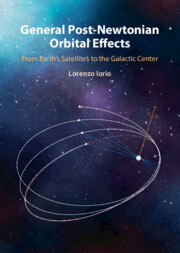Crossref Citations
This Book has been
cited by the following publications. This list is generated based on data provided by Crossref.
Pérez-Cuéllar, Gemma
and
Sabido, Miguel
2024.
On Planetary Orbits, Ungravity and Entropic Gravity.
Universe,
Vol. 10,
Issue. 10,
p.
386.
Iorio, Lorenzo
2024.
Post-Keplerian Perturbations of the Hyperbolic Motion in the Field of a Rotating Massive Object: Analysis in Terms of Osculating and Nonosculating (Contact) Elements.
The Astrophysical Journal,
Vol. 977,
Issue. 1,
p.
44.
Iorio, Lorenzo
2025.
The no-hair theorems at work in M87*.
Monthly Notices of the Royal Astronomical Society,
Vol. 537,
Issue. 2,
p.
1470.
Ciqueira, Ana C. M.
Carvalho, Geanderson A.
Faccin, Paulo H.
and
Dalmolin, Fabrício
2025.
A MOND model applied to the rotation curve of galaxies.
International Journal of Modern Physics D,
Vol. 34,
Issue. 02,
Iorio, Lorenzo
2025.
Lense-Thirring effect at work in
M87*.
Physical Review D,
Vol. 111,
Issue. 4,
Iorio, Lorenzo
2025.
Will LAGEOS and LARES 2 succeed in accurately measuring frame-dragging?.
The European Physical Journal C,
Vol. 85,
Issue. 3,
Wang, Rui-Bo
Ma, Shi-Jie
Deng, Jian-Bo
and
Hu, Xian-Ru
2025.
Estimating the strength of Lorentzian distribution in noncommutative geometry by solar system tests.
Modern Physics Letters A,
Vol. 40,
Issue. 13n14,
Yuan, Huan-Rong
Wang, Ying
Wu, Xin
Xie, Ji-Wei
Liu, Hui-Gen
Zhou, Ji-Lin
and
Sun, Wei
2025.
The Influence of General Relativity on the Spins of Celestial Bodies in Inclined Orbits.
The Astrophysical Journal,
Vol. 980,
Issue. 1,
p.
6.
Jacinto de Matos, Clovis
2025.
On the unphysical nature of gravitomagnetic waves.
Modern Physics Letters A,
Vol. 40,
Issue. 15n16,



